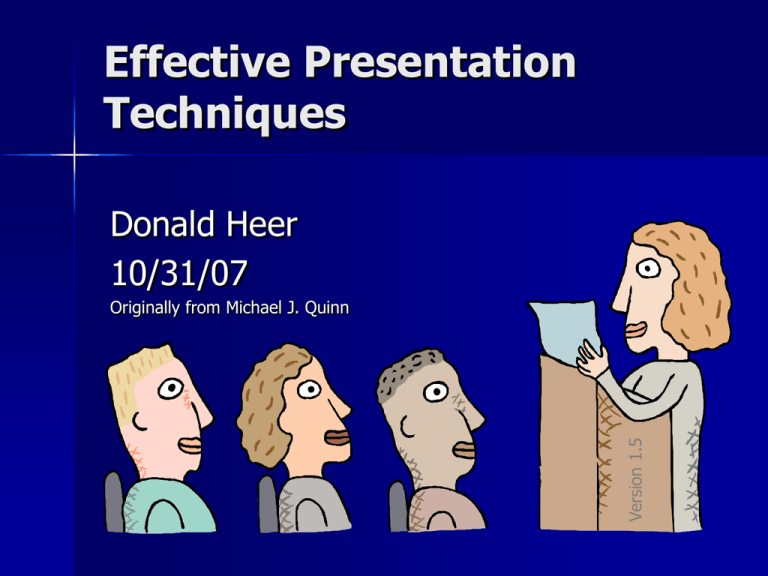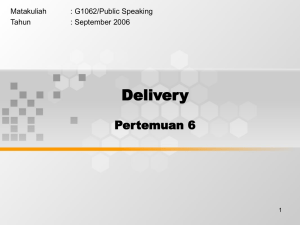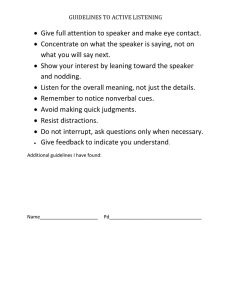Effective Presentation Techniques Donald Heer 10/31/07
advertisement

Effective Presentation Techniques Donald Heer 10/31/07 Version 1.5 Originally from Michael J. Quinn Outline Structuring presentation Designing slides Pausing techniques Answering questions Structuring presentation Designing slides Pausing techniques Answering questions Structuring Presentation Planning Delivery Sign posts Planning Talk: A B Consider audience Set goal Create slides Delivery Prepare audience Move audience Reflect on journey Rehearse! Sign Posts Orient listener – Current topic – Progress Two styles – Intermittent – Ever-present Backing Up First Outline Topic • First point topic • Second point topic • Third topic point Backing Up First Outline Topic • First point topic • Second point topic • Third topic point Backing Up Second First Outline Topic Topic • First point topic • Second point topic • Third point topic Backing Up Second First Outline Topic Topic • First point topic • Second point topic • Third point topic Backing Up Second Third First Outline Topic Topic Topic • First point topic • Second point topic • Third point topic Duplicate Outline Slide Second Third First Outline Topic Topic Topic • First point topic • Second point topic • Third topic point Structuring presentation Designing slides Pausing techniques Answering questions Designing Good Slides Content Unveiling Color Subliminal messages Content Purpose – Complement speaker – Talk ≠ technical report Density – 7 lines/page – 4 words/line Speaker Reads Slides A speaker may put his entire presentation on his slides. He turns his back to the audience and reads the slides aloud. Perhaps he feels this approach guarantees all the information will get to the audience. This may be the most annoying way to give a presentation. Audience members feel insulted: they already know how to read! They wonder why the lecturer doesn’t simply hand out a copy of the slides. The visual presentation dominates the presenter. The presenter is not adding any value to what is on the slides. Speaker Interprets Slides Slides dominate – Provide all content – Hold audience’s attention Speaker supports – Faces slides – Helps audience understand Complicated Derivation ( n) ( n) ( n ) ( n ) / p ( n, p ) p ( (n) (n)) ( n, p ) p (n) (n) p (n, p ) p ( (n) (n)) ( n, p ) (n) (n) ( p 1) (n) p (n, p ) p ( (n) (n)) ( n, p ) (n) (n) T0 (n, p ) ( n) ( n) ( n, p ) (n) (n) T0 (n, p ) ( n, p ) 1 T ( n, p ) 1 0 ( n) ( n) 1 ( n, p ) T ( n, p ) 1 0 T (n,1) ( n, p ) T (n,1) T0 (n, p ) 1 ( n, p ) T (n,1) CT0 (n, p ) ( n, p ) Memory needed per processor Good Illustration > Complicated Derivation Scales poorly Memory Size Scales well Number of processors Dense, Static Slides Keep Making Progress Central Administration College of Arts College of Engineering College of Business Athletics College of Sciences Student Services Keep Making Progress Central Administration College of Arts College of Engineering College of Business Athletics College of Sciences Student Services Keep Making Progress Central Administration College of Arts College of Engineering College of Business Athletics College of Sciences Student Services Slides Enhance Speaker Speaker dominates – Faces audience – Provides content Slides support speaker – Reinforce message – Orient listeners Mixing Important/ Unimportant Words The isoefficiency and the scalability metrics of a parallel algorithm are crucial The typical parallel computers of the future will have thousands of CPUs and terabytes of RAM Important Words Only Crucial metrics – Isoefficiency – Scalability function Future systems – Thousands of CPUs – Terabytes of RAM Unbalanced Lists Speedup – Sequential time – Parallel time Parallel computations Parallel overhead Efficiency Balanced Lists Speedup – Expresses time reduction – Sequential time, parallel time, overhead Efficiency – Expresses processor utilization – Speedup, number of processors “Fly In” Fails Could you read this? How about this one? Maybe the third time is the charm! “Wipe from Left” Works Less distracting Reduces eye movement Increases readability Typical Eye Movement Upper left Upper right Lower left Lower right Image reproduced from www.animationalley.com Wall of White Increases glare Causes eyestrain Distracts from speaker Red/Blue Conflict Red letters on blue background creates “flicker effect” Blue letters on red background just as bad Low Contrast White on yellow Yellow on white Black on blue Blue on black Misleading Emphasis 1 2 4 5 3 6 Subliminal Message: Decline Subliminal Message: Improvement Structuring presentation Designing slides Pausing techniques Answering questions Pauses Useful Powerful Difficult Silence Useful Awaiting thought Switching gaze Reading slide Reinforcing point Structuring presentation Designing slides Pausing techniques Answering questions Pitfalls Hostile gestures Wandering gaze Body language Missing point Seeking approval Excluding audience Opportunities Welcoming gestures Focusing gaze Body language Getting point Reinforcing message Including audience Dangerous Responses “Good question” “I’m glad you asked that question” Summary Guide audience gently Design slides carefully Use pauses effectively Answer questions inclusively



